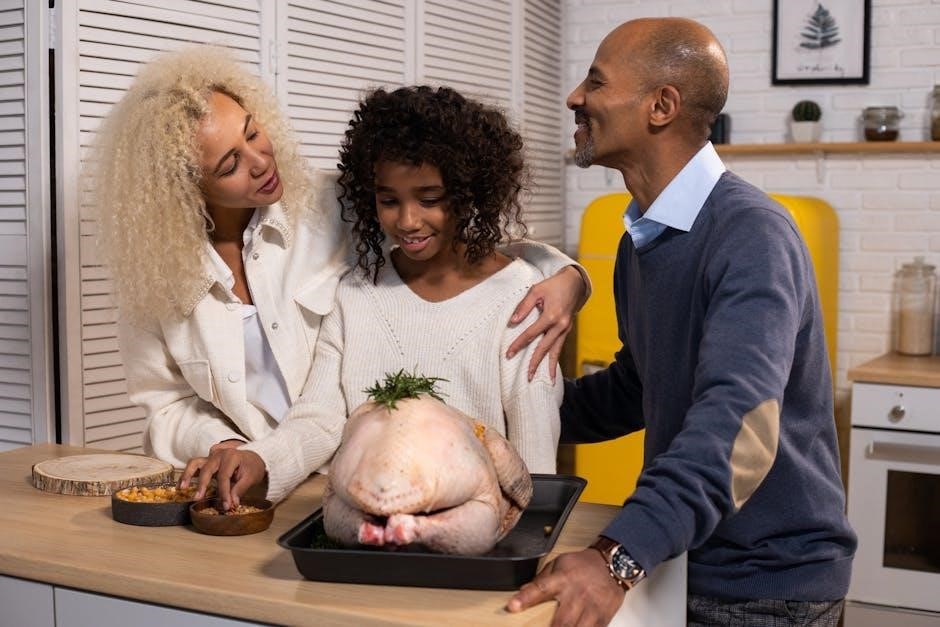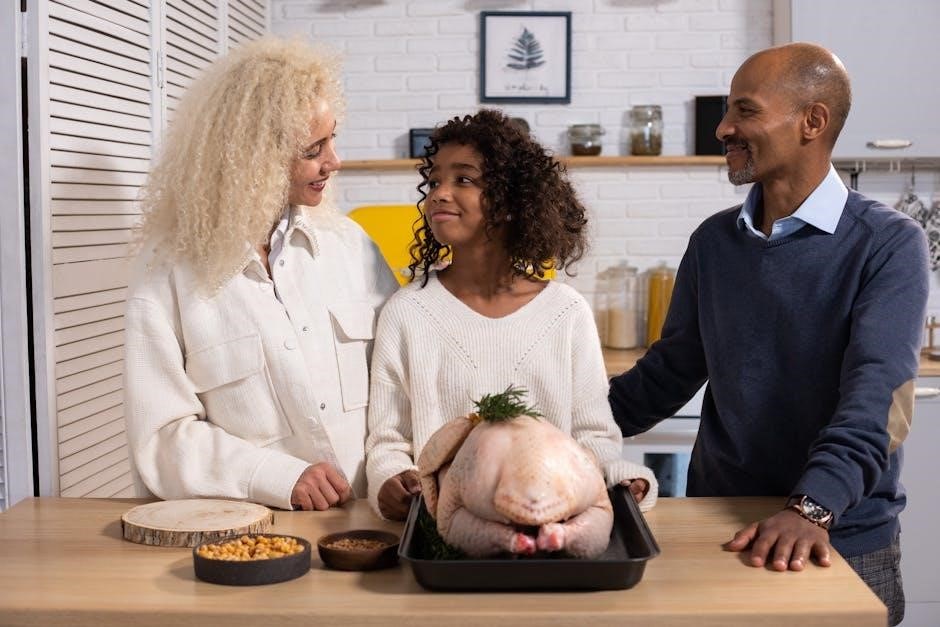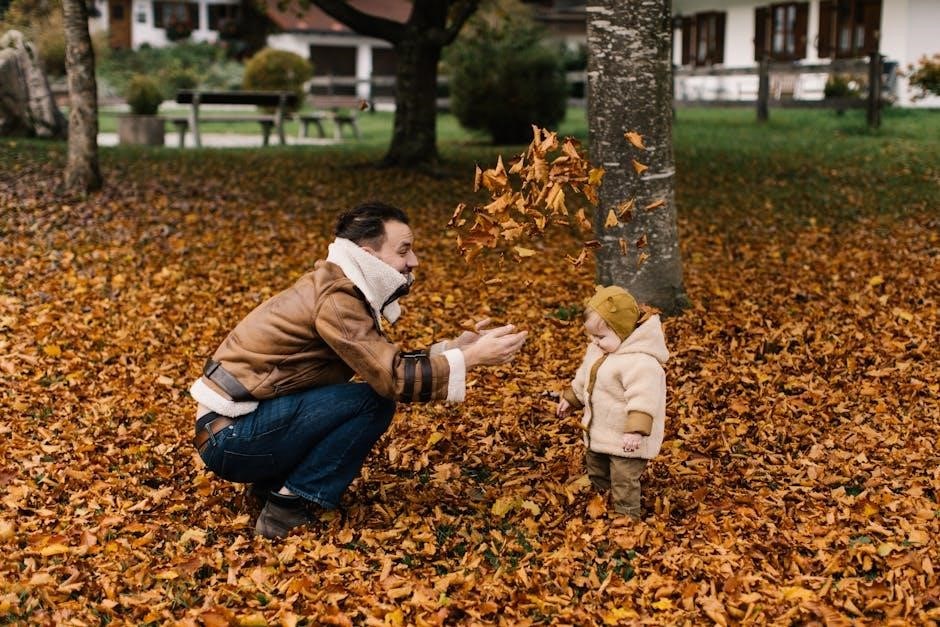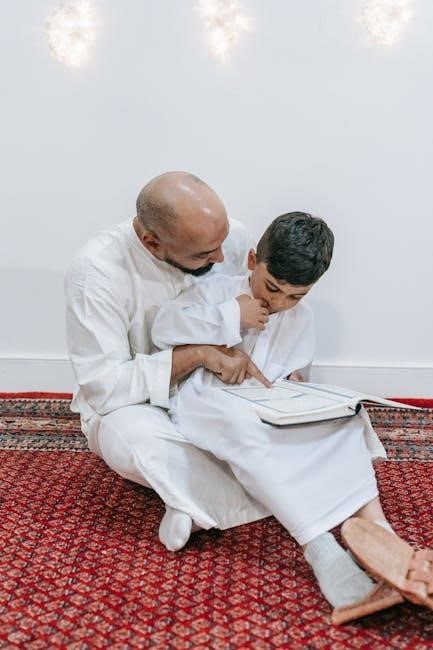Thanksgiving is a cherished holiday where families gather to express gratitude, enjoy traditional meals, and celebrate togetherness. For parents, it’s a perfect opportunity to teach children about the importance of gratitude, cultural traditions, and the historical significance of the day. This guide provides practical tips and ideas to help parents engage their kids in meaningful activities, fostering a deeper understanding of Thanksgiving while creating lasting memories.
Understanding the Importance of Thanksgiving
Thanksgiving is a meaningful holiday that emphasizes gratitude, family, and cultural traditions. It provides an opportunity for parents to teach children the value of appreciating what they have and honoring the people who contribute to their lives. The holiday also offers a chance to reflect on the historical origins of Thanksgiving, fostering a deeper understanding of its significance. By engaging in discussions and activities centered around gratitude, parents can help their children develop a positive outlook and stronger family bonds. This foundation of thankfulness can benefit kids throughout their lives, making Thanksgiving a valuable experience beyond just a meal.
How to Explain Thanksgiving to Children
Explaining Thanksgiving to children involves simplifying its significance while making it engaging. Parents can start by sharing the story of the first Thanksgiving, highlighting how people came together to celebrate and give thanks; Emphasize the importance of gratitude by discussing things children are thankful for, like family, friends, or toys. Using age-appropriate language and activities, such as reading books or crafting, can help kids understand the holiday better. Making it relatable and fun ensures they grasp the core values of Thanksgiving, fostering a sense of appreciation and connection to the tradition. This approach helps build a strong foundation for their understanding of the holiday.

Preparing for Thanksgiving with Kids
Engage children in Thanksgiving prep with fun, age-appropriate tasks like decorating, setting the table, or helping with simple recipes. This makes the celebration a memorable family experience.

Age-Appropriate Activities for Children
Engage your kids in Thanksgiving activities tailored to their age. For toddlers, simple crafts like coloring or making handprint turkeys are perfect. Older children can help with tasks like setting the table or mixing ingredients. Reading Thanksgiving-themed books together fosters a sense of gratitude and understanding. For teenagers, involve them in meal prep or planning the celebration. These activities not only keep children entertained but also teach them valuable skills and the true meaning of the holiday. Make sure to adapt tasks to their abilities and interests for a fun and inclusive experience.
Simple Thanksgiving Crafts for Kids
Keep your little ones entertained with easy and fun Thanksgiving crafts. Start with a handprint turkey using construction paper and paints—a classic activity that sparks creativity. Another idea is a gratitude jar where kids write things they’re thankful for on small paper strips. For older children, create a paper leaf garland by cutting out leaf shapes and decorating them with markers or glitter. These activities not only foster creativity but also teach kids about the holiday’s themes, such as gratitude and family. Simple materials like paper, glue, and crayons make these crafts accessible and enjoyable for all ages, ensuring a memorable Thanksgiving celebration.
Talking to Kids About Thanksgiving History
Teach your children about the first Thanksgiving, highlighting the collaboration between Pilgrims and Native Americans. Discuss the historical feast, cultural exchange, and friendship that shaped the holiday.
The Story of the First Thanksgiving
The first Thanksgiving occurred in 1621 when the Pilgrims, early European settlers, held a harvest feast to celebrate their first successful crop. They were joined by members of the Wampanoag Native American tribe, who had helped them adapt to the new land. This three-day celebration included food, games, and a time of gratitude for the bounty they had received. Explain to your children how this event symbolizes friendship, cooperation, and the importance of giving thanks, setting the foundation for the modern Thanksgiving holiday we celebrate today.
Explaining Cultural Sensitivity
When discussing Thanksgiving with children, it’s important to approach the topic with cultural sensitivity. Many traditional narratives oversimplify or misrepresent the experiences of Native American communities. Parents should acknowledge the historical complexities and ensure children understand the diverse perspectives surrounding the holiday. Emphasize gratitude, friendship, and cooperation while also teaching about the rich cultures of indigenous peoples. Encourage open conversations about history and its impact on different communities. This fosters empathy and a deeper understanding of the holiday’s significance. By promoting respect and awareness, parents can help children celebrate Thanksgiving in a way that honors all voices and traditions.

Managing Kids During the Feast

Managing kids during the feast requires preparation and creativity. Use engaging activities, set clear expectations, and ensure everyone enjoys the meal together.

Keeping Children Engaged During Dinner
Engaging children during Thanksgiving dinner can be achieved through fun and interactive activities. Consider starting with a gratitude circle, where each person shares something they’re thankful for. Simple games like “I Spy” or quiet crafts, such as coloring placemats, can keep kids entertained. Encourage them to participate by asking for their help with small tasks, like passing dishes or setting the table. This fosters a sense of responsibility and inclusion. Additionally, prepare a kid-friendly activity list, such as a Thanksgiving-themed I Spy worksheet or a small puzzle, to ensure they stay occupied and enjoy the family gathering without feeling bored or restless.
Handling Picky Eaters
Dealing with picky eaters during Thanksgiving can be challenging, but there are ways to make mealtime enjoyable for everyone. Involve children in meal preparation, letting them help with simple tasks like mixing or arranging food, which can spark their curiosity. Offer small portions of new dishes alongside familiar favorites to encourage exploration without overwhelming them. Be patient and avoid forcing them to eat, as this can create resistance. Instead, praise their efforts and celebrate small successes. Keep the atmosphere positive and stress-free, ensuring they feel comfortable trying new foods at their own pace. This approach fosters healthy eating habits and familial bonding.

Thanksgiving Safety Tips for Parents
Ensure a safe Thanksgiving by supervising children, securing loose items, and preparing for emergencies. Plan ahead to avoid accidents and stress, creating a enjoyable celebration.
Ensuring a Safe Thanksgiving Celebration
Creating a safe environment for your family is crucial during Thanksgiving. Start by securing furniture and breakable items to prevent accidents, especially with young children around. Plan ahead by preparing a first-aid kit and having emergency contact numbers easily accessible. Supervise kids closely, especially in the kitchen, where hot appliances and sharp utensils pose risks. Additionally, ensure that all food is cooked thoroughly to avoid foodborne illnesses. By taking these precautions, you can minimize potential hazards and focus on enjoying the holiday with your loved ones. A proactive approach ensures a stress-free and joyful celebration for everyone involved. Stay prepared and vigilant to handle any unexpected situations smoothly.
Preventing Choking Hazards
Ensuring your child’s safety during Thanksgiving involves being mindful of choking hazards, especially for young children. Common risks include nuts, popcorn, dry fruits, and small toys. Always supervise mealtime and avoid giving children food that is difficult to chew or swallow. Cut food into small, manageable pieces, and teach kids to chew slowly and thoroughly. Avoid distractions like talking or playing while eating. For younger children, avoid giving them hard or round foods like hot dogs or grapes until they are old enough to handle them safely. By taking these precautions, you can significantly reduce the risk of choking incidents and ensure a safer celebration for your family.

Teaching Gratitude to Children
Teaching gratitude to children is essential for their emotional development. Start by modeling thankful behavior and encouraging kids to express appreciation daily. Use Thanksgiving as a chance to discuss the importance of gratitude and involve them in activities like creating gratitude lists or sharing thankful thoughts. This helps foster a positive and appreciative mindset in children, making the holiday more meaningful for the whole family.
Fostering a Sense of Gratitude
Fostering gratitude in children begins with modeling thankful behavior and creating opportunities for them to reflect on their blessings. Encourage daily expressions of gratitude, such as sharing one thing they’re thankful for at mealtimes. During Thanksgiving, involve kids in activities like writing in a gratitude journal or creating a family gratitude jar. Discuss the importance of appreciating what they have and how it impacts others. Teach them to value both big and small blessings, helping them develop a positive outlook. This mindset not only enriches their lives but also strengthens family bonds, making Thanksgiving a meaningful experience for all.
Practical Ways to Teach Gratitude

Teaching gratitude can be woven into daily routines through simple, engaging activities. Start a family tradition where each member shares something they’re thankful for during meals or before bed. Create a gratitude jar where everyone writes down things they appreciate and reads them aloud on Thanksgiving. Incorporate thankful-themed books and crafts, such as making handprint turkeys with reasons for gratitude written on the feathers. Encourage acts of kindness, like writing thank-you notes or helping others, to instill the value of appreciation. These practices not only make gratitude a habit but also create lasting memories, helping children grow into thankful individuals.
Comments